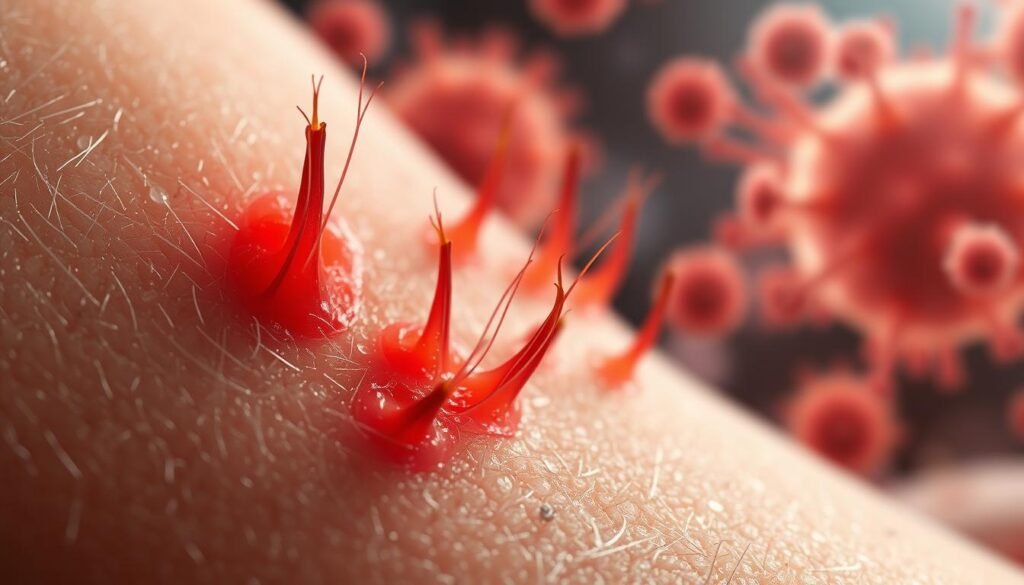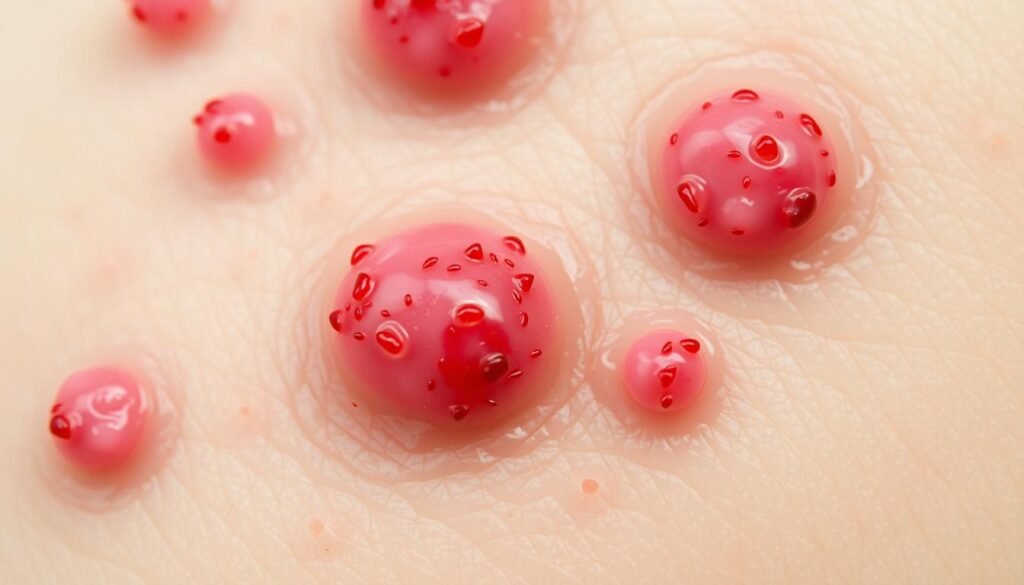About 30% of people with folliculitis deal with chronic cases. This is tough to treat. This skin issue happens when hair follicles get inflamed. It can happen to both adults and kids. Many wonder about its contagious nature. This guide explores folliculitis, its causes, symptoms, and different types.
Most folliculitis cases don’t spread. Yet, some types can, especially if staphylococcus bacteria cause them. Knowing how folliculitis spreads is key. It helps in managing and avoiding it. We’ll cover all you need to know about this condition, including how to prevent and treat it.
Key Takeaways
- Folliculitis can commonly affect people of all ages.
- Most forms are not contagious, but some can spread with staphylococcus bacteria.
- Chronic folliculitis may develop, affecting 30% of individuals.
- Individuals with obesity, diabetes, or long-term antibiotic use are at increased risk.
- Proper skin hygiene can significantly reduce the risk of folliculitis.
What is Folliculitis?
Folliculitis is when hair follicles get inflamed or infected. It’s a common skin issue that can show up anywhere hair grows. This means areas like the face, neck, chest, back, buttocks, and thighs can get it. The scalp, with its many hair follicles, is often affected too. People with this condition might see small red bumps or pimples filled with pus. These signs point to irritation at the hair follicle site.
There are two key types of folliculitis: superficial and deep. Superficial folliculitis touches only the top part of the hair follicle. On the other hand, deep folliculitis goes through the whole follicle and usually means a worse infection. Things like sports or shaving can make it worse since they cause friction. Also, working in a hot, wet place can up your chances of getting it because of more contact with germs.
To avoid folliculitis, keeping your skin clean is crucial. Even though it usually doesn’t spread from person to person, the bugs that cause it can if you touch them. If you keep getting folliculitis, you might need special skin meds from a doctor to take care of it.
Causes of Folliculitis
Folliculitis mainly comes from infections in hair follicles. The big culprits are bacterial infections and fungal infections. Infections usually begin with certain microorganisms. One common bacteria is Staphylococcus aureus, linked to many infections. Another is Pseudomonas aeruginosa, found in warm spa pools.
Fungal infections are also to blame. Malassezia yeast often causes issues in young adults. Candida albicans affects moist areas like skin folds. In places like New Zealand, Microsporum canis causes scalp issues linked to folliculitis.
Actions like shaving, waxing, or wearing tight clothes can irritate hair follicles. This leads to inflammation. People with weaker immune systems, like those with diabetes or HIV, are more prone to folliculitis. They get infections easier.
Here’s a summary of various folliculitis causes:
| Type of Infection | Common Culprit | Key Factors |
|---|---|---|
| Bacterial Infection | Staphylococcus aureus | Common in various skin infections |
| Bacterial Infection | Pseudomonas aeruginosa | Thrive in warm water (hot tubs) |
| Fungal Infection | Malassezia | Common in young adults, upper trunk |
| Fungal Infection | Candida albicans | Skin folds, beard area |
| Fungal Infection | Microsporum canis | Fungal scalp infections |
Knowing these folliculitis causes helps us prevent and treat it better. For more info on treatment, check out these options.
Symptoms of Folliculitis
Folliculitis symptoms vary between people. It often shows as small red bumps on the skin. These bumps may itch or feel tender. They might fill with pus and get crusty as they heal.
Superficial folliculitis affects just the top of hair follicles. This causes clusters of visible bumps. Deep folliculitis, however, leads to larger, painful sores. These sores can scar.
If you’re itching a lot or in discomfort, take note. Recognizing these signs early can help. Getting help quickly can prevent worse problems.
Most folliculitis cases get better on their own, but the itching and bumps can bother you a lot. If problems don’t go away or get worse, seeing a doctor is key.
Is Folliculitis Contagious?
Is folliculitis contagious? This question requires looking at the causes and how they spread. Most folliculitis cases aren’t contagious. However, some types can spread through direct contact in certain situations.
Understanding Contagious Types of Folliculitis
Some folliculitis types are called folliculitis infectious. For instance, the herpes simplex virus can pass via skin contact. Staphylococcal folliculitis, mainly from folliculitis bacteria, spreads among people, especially through open cuts or sores.
Hot tub folliculitis is another contagious type. It’s caused by the bacterium Pseudomonas aeruginosa found in poorly maintained hot tubs. It can spread among users sharing the water.
Non-Contagious Forms of Folliculitis
Then, there are non-contagious forms of folliculitis. These don’t come from infections. They’re from shaving issues, ingrown hairs, and skin blockages. Normally, these cases aren’t contagious. They get better on their own or with simple treatment.
People with folliculitis from shaving find relief through good shaving methods and skin care. For more info on this, check out this helpful source.

Different Types of Folliculitis
It’s key to know the types of folliculitis for right treatment. This condition is split into groups like bacterial and fungal. Each has its causes and signs.
Bacterial Folliculitis
Bacterial folliculitis is the most common kind. It usually comes from infections by Staphylococcus aureus. You might see itchy, pus-filled bumps on hairy areas like legs and scalp. Usually, it goes away in 7 to 10 days without needing treatment.
Another kind is hot tub folliculitis. It happens from poorly kept hot tubs with Pseudomonas aeruginosa growth. This type often gets better in two weeks without antibiotics.
Fungal Folliculitis
Fungal folliculitis, like Malassezia, is linked to yeast infections. It mostly hits the upper body of teenagers and young men. This is more in humid places or if you sweat a lot. Itchy, red follicles are common signs. You’ll need antifungal meds, as antibiotics won’t work.
Other fungal folliculitis types are more rare. For example, eosinophilic folliculitis, which can happen with specific conditions like HIV.
Knowing these folliculitis types helps pick the right treatment. For deeper insights, see this resource.
How Folliculitis Spreads
Folliculitis can spread in different ways, like skin contact with an infected person or dirty objects. Knowing how it spreads helps with prevention and treatment. This knowledge helps people be proactive.
Ways of Transmission
Folliculitis can spread in various ways:
- Direct skin contact with an infected person.
- Sharing personal items like razors, towels, or clothes.
- Using not well-maintained hot tubs or swimming pools, which can contain bacteria like Pseudomonas aeruginosa.
- Being in close-contact sports with a lot of skin touching.

Risk Factors for Transmission
Some factors make folliculitis spread more likely. It’s good to be aware of these:
| Risk Factor | Description |
|---|---|
| Shared Environments | Places like pools and gyms where skin contacts are common. |
| Personal Habits | Shaving or waxing often can irritate skin and increase risk. |
| Compromised Immune System | People with HIV or cancer treatments are at higher risk. |
| Tight Clothing | Tight or non-breathable clothes can irritate hair follicles. |
| Excessive Sweating | More sweat can block follicles, leading to skin irritation. |
Knowing these factors can help manage the risk of spreading folliculitis. Taking the right precautions is key. For more tips, check out details on folliculitis transmission.
Folliculitis Prevention Tips
To stop folliculitis, follow some easy steps to keep your skin clean and avoid irritants. These steps can greatly lower your chances of getting this skin issue.
Maintain Skin Hygiene
Keeping your skin clean is key to stopping folliculitis. Use gentle antibacterial soaps like Dial® or Cetaphil®. They cleanse the skin and get rid of bad bacteria. It’s good to wash areas that could get infected every day. This is especially true after you’ve been sweating or after things that rub your skin. Showering with warm water can calm your skin, making it less likely to get irritated.
Avoiding Irritants and Blockages
To avoid folliculitis, stay away from things that can clog your hair follicles. Wear clothes that don’t fit too tightly to reduce rubbing. Avoid tight bandages and thick lotions that can block your pores. If you shave often, gently exfoliating can help keep hair follicles open. This reduces the chance of hairs growing back into the skin.
By doing these things, you can keep your skin healthy and avoid folliculitis.
Folliculitis Treatment Options
To treat folliculitis well, we often combine home remedies with medical treatments. The approach depends on how serious the condition is. For mild cases, simple steps can work well. But chronic or severe cases might need help from health experts.
Home Remedies
Home remedies can really help with the symptoms. Warm compresses are good for soothing and reducing swelling. You can also try antibacterial creams from the store for mild problems. It’s important to keep everything clean to help heal and stop more irritation. Avoid things that could inflame the area more, like tight clothes or a lot of sweating.
Medical Treatments
If the problem is big, you’ll likely need medical treatments. Doctors often suggest topical antibiotics, which work for about 80% of people in two weeks. For the tougher cases, oral antibiotics like doxycycline are used. They’re good for different skin infections. There’s also topical corticosteroids to calm inflammation. For ongoing issues, a dermatologist might recommend laser therapy. Always talk to a health professional to get the right treatment plan for you.

| Treatment Type | Description | Effectiveness |
|---|---|---|
| Home Remedies | Warm compresses, topical antibacterial creams | Effective for mild cases |
| Topical Antibiotics | Prescribed for mild to moderate folliculitis | Improvement in 80% of patients within two weeks |
| Oral Antibiotics | Doxycycline for severe or recurrent cases | Addresses various skin infections |
| Topical Corticosteroids | Reduces inflammation in affected areas | Variable effectiveness based on severity |
| Laser Therapy | Recommended for persistent folliculitis | Effectiveness varies by individual |
When to See a Doctor for Folliculitis
If you have ongoing or worsening symptoms of folliculitis, it’s time to see a doctor. Some signs that you really need a medical opinion include:
- Firm, painful bumps on the skin
- Drainage of pus from the affected area
- Fever associated with skin irritation
- Swollen lymph nodes near the afflicted region
Getting advice from a healthcare provider is key, especially if the infection is on your face. If not treated, severe folliculitis can cause scars. A skilled doctor can accurately identify the problem and suggest how to treat it.
Don’t ignore the signs. Doing so might lead to more problems, like secondary skin infections. These can happen in 10-20% of severe cases. Getting help early means a better and smoother recovery.
Conclusion
It’s crucial to know about folliculitis, not just to spot symptoms but also to understand how it spreads. Most cases come from non-contagious causes like bacteria from Staphylococcus aureus. Yet, it’s key to know when it can be passed on. This is especially so in places like hot tubs, which if not clean, can cause hot tub folliculitis in many people.
If you see signs like red bumps or blisters filled with pus, it’s important to stay clean to prevent spreading it. Seeing a doctor can help get the right treatment for different folliculitis types. Knowing about folliculitis well means you can keep your skin healthy and avoid more outbreaks.
Preventing folliculitis is super important, especially for those who easily get sick or are more likely to get certain types. Staying aware and clean helps not just with treating folliculitis but also in preventing it in the future.
